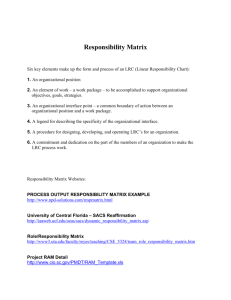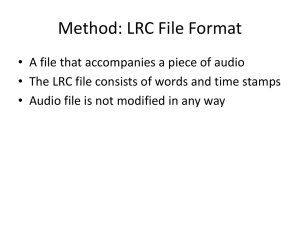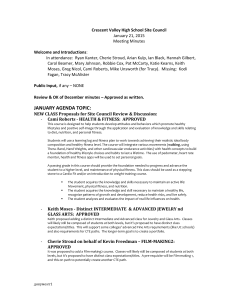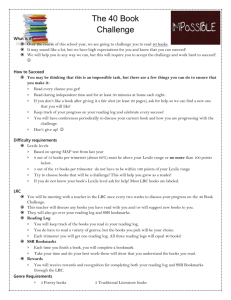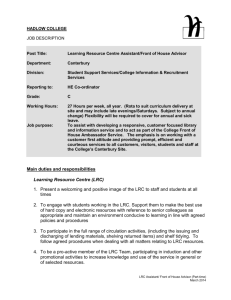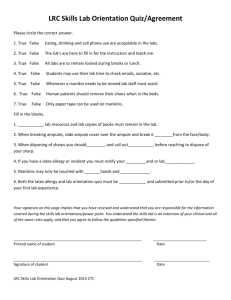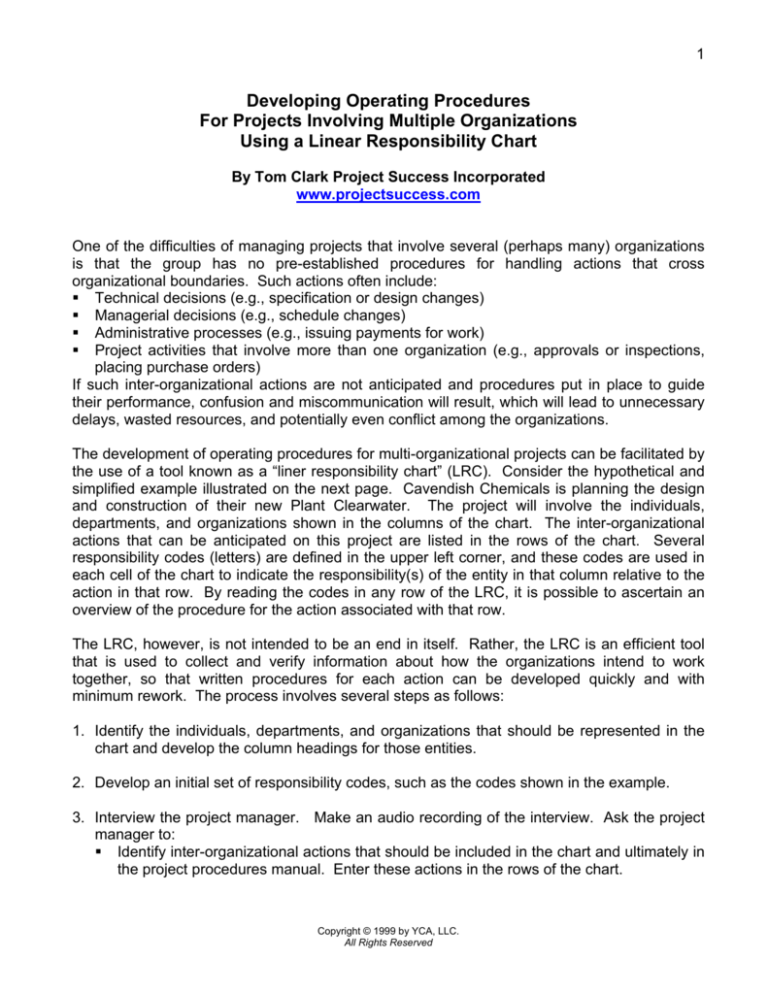
1
Developing Operating Procedures
For Projects Involving Multiple Organizations
Using a Linear Responsibility Chart
By Tom Clark Project Success Incorporated
www.projectsuccess.com
One of the difficulties of managing projects that involve several (perhaps many) organizations
is that the group has no pre-established procedures for handling actions that cross
organizational boundaries. Such actions often include:
Technical decisions (e.g., specification or design changes)
Managerial decisions (e.g., schedule changes)
Administrative processes (e.g., issuing payments for work)
Project activities that involve more than one organization (e.g., approvals or inspections,
placing purchase orders)
If such inter-organizational actions are not anticipated and procedures put in place to guide
their performance, confusion and miscommunication will result, which will lead to unnecessary
delays, wasted resources, and potentially even conflict among the organizations.
The development of operating procedures for multi-organizational projects can be facilitated by
the use of a tool known as a “liner responsibility chart” (LRC). Consider the hypothetical and
simplified example illustrated on the next page. Cavendish Chemicals is planning the design
and construction of their new Plant Clearwater. The project will involve the individuals,
departments, and organizations shown in the columns of the chart. The inter-organizational
actions that can be anticipated on this project are listed in the rows of the chart. Several
responsibility codes (letters) are defined in the upper left corner, and these codes are used in
each cell of the chart to indicate the responsibility(s) of the entity in that column relative to the
action in that row. By reading the codes in any row of the LRC, it is possible to ascertain an
overview of the procedure for the action associated with that row.
The LRC, however, is not intended to be an end in itself. Rather, the LRC is an efficient tool
that is used to collect and verify information about how the organizations intend to work
together, so that written procedures for each action can be developed quickly and with
minimum rework. The process involves several steps as follows:
1. Identify the individuals, departments, and organizations that should be represented in the
chart and develop the column headings for those entities.
2. Develop an initial set of responsibility codes, such as the codes shown in the example.
3. Interview the project manager. Make an audio recording of the interview. Ask the project
manager to:
Identify inter-organizational actions that should be included in the chart and ultimately in
the project procedures manual. Enter these actions in the rows of the chart.
Copyright © 1999 by YCA, LLC.
All Rights Reserved
2
Talk through the procedure for each action as he or she would prefer that it be
performed. Enter responsibility codes into the cells of the chart to capture the
procedure as described. If necessary, create additional codes.
Copyright © 1999 by YCA, LLC.
All Rights Reserved
3
Cavendish Chemicals, Inc.
Linear Responsibility Chart
For
Design and Construction of Plant Clearwater
RESPONSIBILITY CODES
A/B
C
E
E
Plant design changes
E
E
C
A/B
C
C
Design schedule changes
D
B
A/C
A/C
Construction schedule changes
D
B
A
C
C
E
County inspections
E
E
E
A
E
EPA inspections
A
E
E
D
E
E
County Bldg. Inspector
General Contractor
E
EPA
Architect
D
Equipment Vendors
Plant Engineering
Process design specification
changes
ACTION
Subcontractors
Process Engineering
Cavendish Chemicals
Project Manager
Requests / Initiates
Performs / Takes Action
Must Be Consulted
Must Approve
Must Be Informed
VP - Production
A.
B.
C.
D.
E.
INDIVIDUAL / DEPARTMENT / ORGANIZATION
D
C
E
B/D
E
B/D
Owner inspections
E
B/D
E
E
Payments
B
D
D
A
Copyright © 1999 by YCA, LLC.
All Rights Reserved
A
A
5
4. Interview other key individuals who are identified in the LRC or who represent departments
or organizations identified in the chart. The order in which these interviews are conducted
is not critical. Show each interviewee the actions that have been entered into the LRC by
previous interviewees. Ask the interviewee to identify additional actions that should be
included and to describe the preferred procedure. Again, enter the appropriate codes in
the LRC, create additional codes if necessary, and make an audio recording of the
interview.
5. When the interviews have been completed, hold a meeting of the key individuals who are
identified in the LRC or who represent departments or organizations identified in the LRC.
Make an audio recording of the meeting. Give out copies of the LRC.
Explain the procedure for each action as described by the responsibility codes. Ask for
comments, suggestions, or concerns on the procedure for each action. Seek
consensus on all changes. Make changes to the codes as appropriate.
Ask for any additional actions that should be added to the LRC. Have the group discuss
the preferred procedure for any such actions and record the appropriate codes on the
LRC. Again, seek consensus.
6. Using the LRC (and audio recordings as necessary), develop a project procedures manual.
Each row on the LRC should be converted to a written procedure. Each procedure should
have:
a. Date and draft number
b. Action name/description (e.g., “Construction schedule changes”)
c. Statement of the procedure based on the codes in the LRC. In addition, the statement
can contain details, such as:
When making a submittal, exactly what documentation to provide and to whom it
should be sent.
How long an entity normally has to review and act on an item submitted for their
approval.
Who should receive copies of certain communications.
Whether hard copy or electronic communication are required/allowed.
d. Signature lines for the project manager and for other key individuals who are identified
in the LRC or who represent departments or organizations identified in the LRC. The
signatures indicate that these key individuals approve the procedure and that they will
follow and require other members of their organization follow the procedure.
In addition to the individual procedures, the procedures manual should contain:
A table of contents
A directory of key individuals involved in the project, including phone numbers, mailing
addresses, and email addresses
The final LRC on which the procedures are based
A glossary of terms, if necessary
7. Distribute the procedures manual to all involved organizations in hard copy and/or
electronic format.
The early development of a procedures manual as described above has proven invaluable on
projects involving multiple organizations. The application of the LRC in the context of the steps
Copyright © 1999 by YCA, LLC.
All Rights Reserved
6
outlined above greatly facilitates the process, and it ensures that the procedures manual is
complete and represents consensus among the involved organizations.
About the Author, the Project Success Method & Project Success Inc
Thomas B. (Tom) Clark, Ph.D.
Co-founder and former Executive Vice President
Tom is heavily involved in the development and delivery of PSI’s courses. In addition to his
work with PSI, he is Professor Emeritus of Management at Georgia State University. He also
served the University as Chair of the Department of Management and as Interim Dean of the
College of Business Administration. Previously, he was an Assistant Professor of Industrial
and Systems Engineering at Georgia Tech.
Tom has provided project management consulting and training services for a variety of
business, government, and non-profit organizations. He developed and marketed one of the
first PC-based software tools for project scheduling and cost control. Prior to beginning his
academic career, Tom served in the U.S. Army Management Systems Support Agency at the
Pentagon and was employed as an industrial engineer with a national firm in the printing
industry. He holds bachelors and masters degrees in Industrial Engineering from Georgia Tech
and a Ph.D. in Business Administration from Georgia State University. Tom has received
several awards for teaching excellence and public service.
Since 1983, Atlanta, GA based Project Success Incorporated (formerly YCA) has been
providing Project Success Method project management training and consulting services to
hundreds of successful organizations, including many of the largest and most profitable
Fortune 500 companies.
The Project Success clearly defines a proven approach to superior project performance.
While an estimated 70% to 90% of corporate strategic initiatives fail, companies that employ
The Project Success Method® consistently plan and control their projects successfully,
delivering projects faster, more effectively, and at lower cost.
The Project Success Method is a blueprint for planning and controlling projects of all sizes
and provides the missing link between strategy formulation and implementation. The
methodology is not software-specific and requires no prior project management training or
professional certification. Most importantly, the Project Success MethodSM is easy to learn,
highly effective and can be implemented quickly in as little as 5 days.”
PSI consultants have been engaged in more than 10,000 projects in 25 countries on six
continents. For more information contact walter.urban@projectsuccess.com or visit
www.projectsuccess.com.
Copyright © 1999 by YCA, LLC.
All Rights Reserved

